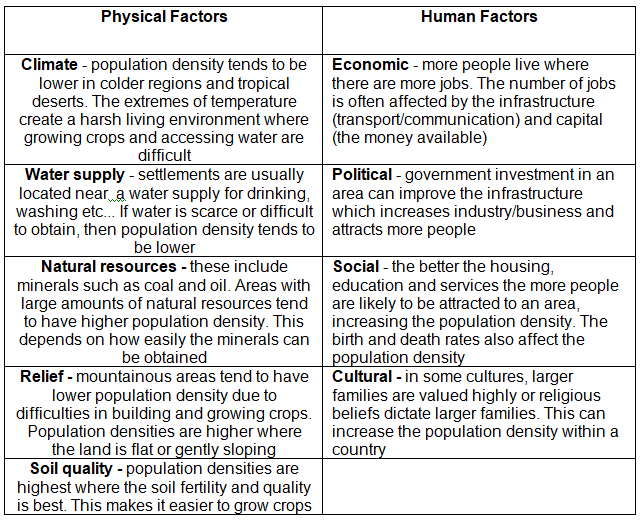Year 11 Exam > Year 11 Notes > Geography for GCSE/IGCSE > Factors Affecting Population Density & Distribution
Factors Affecting Population Density & Distribution | Geography for GCSE/IGCSE - Year 11 PDF Download
Population Density & Distribution
- Population density differs worldwide
- Population distribution defines how the global population is dispersed
- Calculating population density involves dividing total population by total area

- Monaco holds the title for the highest population density globally, with 26,337 individuals per square kilometer as of 2022.
- Conversely, Greenland boasts the lowest population density worldwide, with less than 0.2 individuals per square kilometer in 2022.
- The global population density averaged around 59.27 individuals per square kilometer in 2022.
- Population distribution varies significantly, with some regions densely populated while others remain sparsely populated.
- Various factors, both natural and human-induced, influence population density across different regions.

Question for Factors Affecting Population Density & DistributionTry yourself: What does population density refer to?View Solution
Case Study: Singapore
- Singapore exhibits a population density of 8,358 individuals per square kilometer.
- Although classified as a city-state, Singapore doesn't rank as the most densely populated city globally; rather, it stands as the third most densely populated country.

Causes of the High-Density Population
- Singapore spans merely 716 square kilometers, hosting its population within a confined space.
- Featuring a tropical climate, temperatures in Singapore range consistently between 25°C and 27°C.
- The terrain is predominantly habitable, flat, or gently sloping, with the highest elevation reaching just 165 meters above sea level.
- The region boasts exceptional water access and a well-developed infrastructure and communication network.
- Singapore maintains low crime rates, a stable government, and experiences high levels of immigration.
- It houses the world's busiest port in terms of shipping tonnage.
Effects of High Population Density
- Scarcity of housing leading to shortages.
- Escalation of rents and property prices due to high demand.
- Limited agricultural land use at only 1%, necessitating the importation of a majority of food supplies.
- Strain on infrastructure, notably public transport and essential services like schools.
- Rise in waste production, impacting environmental sustainability.
- Heightened levels of air and water pollution, posing health and environmental risks.
Case Study: Mongolia
- Mongolia covers an extensive area of 1,564,000 square kilometers.
- The population density stands at 2 individuals per square kilometer.

Causes of the low population density
- The region experiences severe weather conditions, with extremely cold winters reaching temperatures as low as -30°C.
- Elevated terrains, primarily ranging between 900 to 1500 meters above sea level, contribute to the challenging living conditions.
- Large expanses of desert and semi-desert landscapes hinder settlement and agricultural activities.
- With a brief growing season lasting about 90 days, agriculture is notably arduous due to the climate and terrain characteristics.
- Mongolia's landlocked status poses challenges for trade and economic development.
- Inadequate infrastructure and limited communication networks, with only about 20% of roads being paved, impede connectivity.
- A significant portion of the rural population relies on livestock herding as their primary source of livelihood, further constrained by shortages of grazing pastures resulting from harsh weather fluctuations.
- The population grapples with low birth rates, impacting demographic growth.
Impacts of Low Population Density
- Challenges in accessing essential services like healthcare and education, especially in rural regions.
- Limited access to markets and trade opportunities.
- Scarcity of economic ventures.
- Heightened migration from rural to urban areas.
Question for Factors Affecting Population Density & DistributionTry yourself: What is one of the effects of high population density in Singapore?View Solution
The document Factors Affecting Population Density & Distribution | Geography for GCSE/IGCSE - Year 11 is a part of the Year 11 Course Geography for GCSE/IGCSE.
All you need of Year 11 at this link: Year 11
|
57 videos|70 docs|80 tests
|
FAQs on Factors Affecting Population Density & Distribution - Geography for GCSE/IGCSE - Year 11
| 1. What are some factors that can affect population density and distribution? |  |
Ans. Factors such as climate, terrain, resources, economic opportunities, political stability, and infrastructure can all influence population density and distribution.
| 2. How does high population density impact a country like Singapore? |  |
Ans. High population density in Singapore can lead to challenges such as limited space for housing, increased traffic congestion, strain on public services, and pressure on natural resources.
| 3. What are some of the effects of severe winters and hot summers on population distribution in Mongolia? |  |
Ans. Severe winters and hot summers in Mongolia can impact population distribution by making certain areas less habitable due to extreme weather conditions, leading to uneven population distribution.
| 4. How does infrastructure play a role in population density and distribution? |  |
Ans. Good infrastructure, such as transportation networks and access to services, can attract people to live in certain areas, increasing population density. Conversely, poor infrastructure can deter people from settling in certain regions.
| 5. How does political stability affect population density and distribution in a country? |  |
Ans. Political stability can influence population density and distribution by creating a safe and secure environment for people to live and work in, leading to increased settlement and population growth. On the other hand, political instability can drive people away from certain areas, reducing population density.

|
Explore Courses for Year 11 exam
|

|
Signup for Free!
Signup to see your scores go up within 7 days! Learn & Practice with 1000+ FREE Notes, Videos & Tests.
Related Searches
















